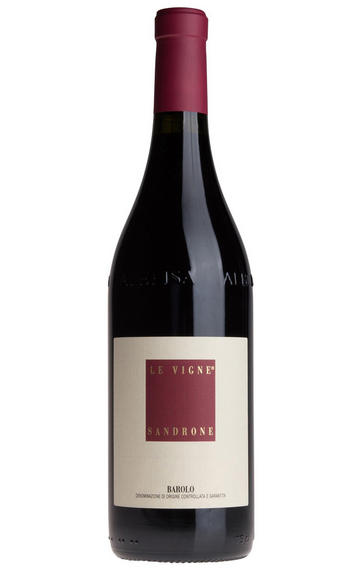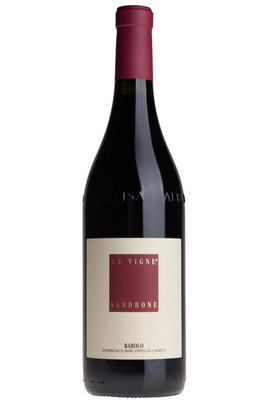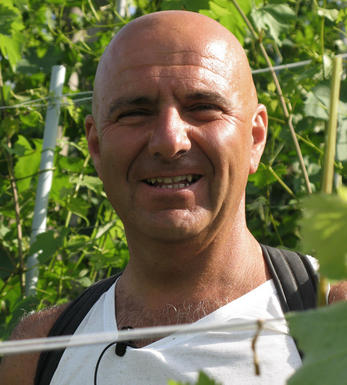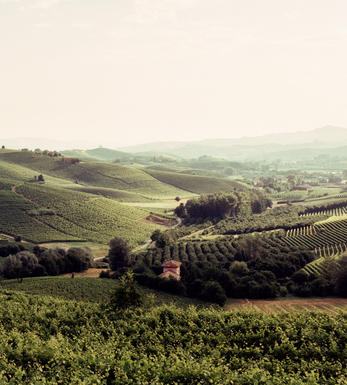
2004 Barolo, Le Vigne, Luciano Sandrone, Piedmont, Italy

Critics reviews
Antonio Galloni - Wine Advocate - Issue#174 Dec 2007
Antonio Galloni - 28/12/2007
About this WINE

Luciano Sandrone
Today, Sandrone is one of Barolo’s most admired names, but this producer came from humble beginnings. The son of the local carpenter, Luciano Sandrone always dreamed of owning his own vineyard and making his own wine. He achieved his lifelong ambition in 1978, buying a small plot in Cannubi Boschis. This now-legendary vineyard proved pivotal in securing his family’s fortunes; Luciano’s wines were among the first in the region to garner worldwide acclaim. Driven by Luciano’s clarity of vision, the estate has since expanded to over 20 hectares. His original vineyard, now in front of the family’s home and winery, produces the fruit that goes into their Aleste Barolo. Since the early ’90s, Luciano has worked alongside his children Luca and Barbara, and increasingly his grandchildren Alessia and Stefano.
Barbara Sandrone beams with pride for ’18, which draws similarities to the great ’08 and ’12 vintages. It was a challenging growing year in the vineyards, but the end of the growing season was calm, and the resulting wines are classical and fine. The suppleness of the vintage mutes some of the firm intensity we know from Sandrone, but the wines do not suffer from it. Instead, they feel alive and open, coiled with that serious, polished edge we know and admire from this resplendent family cantina.

Barolo
Located due south of Alba and the River Tanaro, Barolo is Piedmont's most famous wine DOCG (Denominazione di Origine Controllata e Garantita), renowned for producing Italy's finest red wines from 100 percent Nebbiolo.
Its red wines were originally sweet, but in 1840 the then extant Italian monarchy, the House of Savoy, ordered them to be altered to a dry style. This project was realised by French oenologist Louis Oudart, whose experience with Pinot Noir had convinced him of Nebbiolo's potential. The Barolo appellation was formalised in 1966 at around 1,700 hectares – only a tenth of the size of Burgundy, but almost three times as big as neighbouring Barbaresco.
Upgraded to DOCG status in 1980, Barolo comprises two distinct soil types: the first is a Tortonian sandy marl that produces a more feminine style of wine and can be found in the villages of Barolo, La Morra, Cherasco, Verduno, Novello, Roddi and parts of Castiglione Falletto. The second is the older Helvetian sandstone clay that bestows the wines with a more muscular style. This can be found in Monforte d'Alba, Serralunga d'Alba, Diano d'Alba, Grinzane Cavour and the other parts of Castiglione Falletto. Made today from the Nebbiolo clones Lampia, Michet and Rosé, Barolo has an exceptional terroir with almost every village perched on its own hill. The climate is continental, with an extended summer and autumn enabling the fickle Nebbiolo to achieve perfect ripeness.
Inspired by the success of modernists such as Elio Altare, there has been pressure in recent years to reduce the ageing requirements for Barolo; this has mostly been driven by new producers to the region, often with no Piedmontese viticultural heritage and armed with their roto-fermenters and barriques, intent on making a fruitier, more modern style of wine.
This modern style arguably appeals more to the important American market and its scribes, but the traditionalists continue to argue in favour of making Barolo in the classic way. They make the wine in a mix of epoxy-lined cement or stainless-steel cuves, followed by extended ageing in 25-hectoliter Slavonian botte (barrels) to gently soften and integrate the tannins. However, even amongst the traditionalists there has been a move, since the mid-1990s, towards using physiologically (rather than polyphenolically) riper fruit, aided by global warming. Both modernist and traditional schools can produce exceptional or disappointing wines.
Recommended traditionalist producers:
Giacomo Borgogno, Giacomo Conterno, Bruno Giacosa, Elio Grasso, Marcarini, Bartolo Mascarello and Giuseppe Mascarello.
Recommended nmdernist producers:
Azelia, Aldo Conterno, Luciano Sandrone, Paolo Scavino and Roberto Voerzio

Nebbiolo
Nebbiolo is the grape behind the Barolo and Barbaresco wines and is hardly ever seen outside the confines of Piedmont. It takes its name from "nebbia" which is Italian for fog, a frequent phenomenon in the region.
A notoriously pernickety grape, it requires sheltered south-facing sites and performs best on the well-drained calcareous marls to the north and south of Alba in the DOCG zones of Barbaresco and Barolo.
Langhe Nebbiolo is effectively the ‘second wine’ of Piedmont’s great Barolo & Barbarescos. This DOC is the only way Langhe producers can declassify their Barolo or Barbaresco fruit or wines to make an early-drinking style. Unlike Nebbiolo d’Alba, Langhe Nebbiolo can be cut with 15% other red indigenous varieties, such as Barbera or Dolcetto.
Nebbiolo flowers early and ripens late, so a long hang time, producing high levels of sugar, acidity and tannins; the challenge being to harvest the fruit with these three elements ripe and in balance. The best Barolos and Barbarescos are perfumed with aromas of tar, rose, mint, chocolate, liquorice and truffles. They age brilliantly and the very best need ten years to show at their best.


Buying options
Add to wishlist
Description
The 2004 Barolo Le Vigne is one of the darkest, most intense Le Vignes I can remember tasting. In this vintage, the fruit is especially somber, the legacy of the late harvest season. Black cherries, plums, cinnamon, flowers, mint and leather meld together in a sumptuous, exceptionally polished Le Vigne that will continue to drink well for many years. Le Vigne is often slow to get out of the gate, which appears to be the case with the 2004 as well. 96/100
Antoni Galloni - Vinous - May 2015
wine at a glance
Delivery and quality guarantee